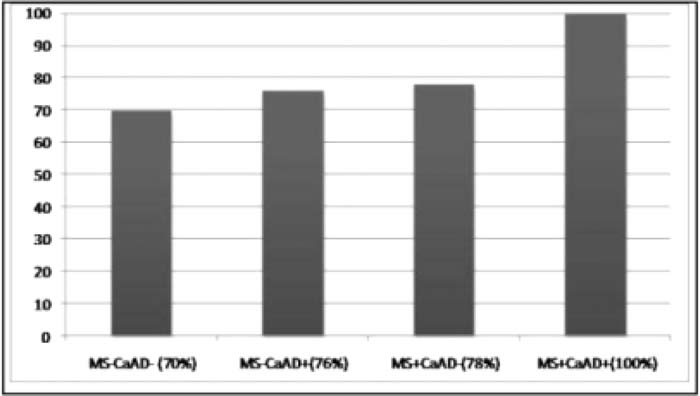Background:
Metabolic syndrome (MetS) portends an increased risk of coronary artery disease (CAD), independent of traditional risk factors, and is also associated with increased carotid intimal wall thickness. Metabolic syndrome has also been associated with an increased rate of progression of aortic stenosis (AS) and an accelerated rate of degeneration of bioprosthetic aortic valves. The purpose of this study was to compare metabolic syndrome versus traditional risk factors as a predictor of significant coronary and carotid artery disease in patients with moderate to severe aortic stenosis.
Methods:
This study was a retrospective review of 92 patients who had aortic valve replacement between January 2006 and December 2008 at Regions Hospital, St. Paul. The clinical identification of patients with MetS was based on the modified criteria proposed by the National Cholesterol Education Program — Adult Treatment Panel III. Significant CAD was defined as the presence of luminal stenosis ≥ 50% in the angiographic data. Significant carotid artery disease (CaAD) was defined as the presence of a luminal stenosis ≥ 50% in duplex ultrasonography. All statistical analyses were performed using STATA 10.0 software (StalaCorp, TX) with the t test, X2 test, or Fisher's exact test and logistic regression. A P < 0.05 was considered statistically significant.
Results:
The average age of the study population was 71 ± 9 years, with the majority of patients being male (66 of 92). The average aortic valve area was 0.9 ± 0.2 cm2, The presence of a significant CAD in 1 vessel was detected in 74 of 92 patients (80%), whereas significant CaAD was present in 41 of 92 patients (45%). Significant CAD was present in 37 of 41 patients with CaAD (90%) and in 37 of 51 patients (73%) without CaAD (P = 0.03). etS was present in 42 of 92 patients (45%) with moderate to severe aortic stenosis. The prevalence of significant CAD in patients with MetS was 90% (38 of 42), and in patients with no‐MetS it was 72% (36 of 50), P = 0.03, Significant CaAD was present in 57% (24 of 42) of the patients with MetS and in 34% (17 of 50) of the patients with No‐MetS (P = 0.02), In multivariate logistic regression analysis, MetS was the only predictor of significant CAD and CaAD in patients with moderate to severe aortic stenosis. MetS was associated with a 3.75‐fold increase in the risk of significant CAD, a 2.59‐fold increase in the risk of significant CaAD, and a 2.63‐fold increase in the risk of concomitant, significant CAD and CaAD. The combination of 2 variables (MetS and CaAD) allowed for the identification of 4 groups with an increasing prevalence of CAD: (1) MetS‐/CaAD‐, 70%; (2) MetS‐/CaAD+, 76%; (3) MetS+/CaAD‐, 78%; and (4) MetS+/CaAD+, 100% (P = 0.03; Fig. 1).
Figure 1. Prevalence of coronary artery disease (CAD%) in 4 groups according to the presence (+) or absence (−) of metabolic syndrome (MetS) and carotid artery disease (CaAD).
Conclusions:
MetS appears to be a strong independent predictor of both significant CAD and CaAD, in patients with moderate to severe AS. Patients diagnosed with AS should be systematically screened for the presence of MetS, and those patients diagnosed with MetS should be screened for CAD and CaAD.
Author Disclosure:
I. Ahmed, none; W. Nelson, none; C. House, none; R. Dahiya, none; D. Zhu, none.

